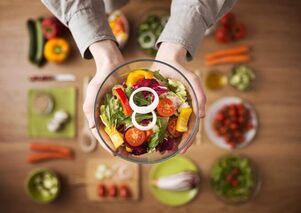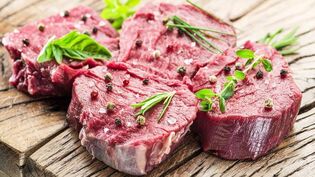Japanese cinemas and animations are mesmerizing with their original atmosphere, great pictures, the beauty and slimness of Japanese women. The Japanese are recognized as the slender people in the world. The secret is not only in the peculiarities of a slender country, but also in the simplification of portions and a healthy diet. The name "Japanese diet" alone is interesting. What does it take to turn into a fragile geisha? Let's think!
The reason why the Japanese diet is called that may not be clear, but the results of its approach are impressive - in two weeks you can lose 4-8 kg, depending on the initial weight. One source says that the approach was developed in Tokyo clinics, the other - the transparency of rules and diet patterns determine a clear path to achieving this goal. Those who try will be rewarded - reminiscent of the samurai way.
Japanese food for 14 days (original version) is world famous, its list of products available and simple. Japanese nutritionist Naomi Moriyama claims that low-carb and low-carb foods help maintain youthful vigor and longevity.

According to Moriyama research statistics, Japanese people consume 25% fewer calories than other countries. Fatty foods, fatty foods, and the consumption of butter on an industrial scale are not popular in this country. Healthy food and small portions are a feature of Japanese culture.
This principle fits the Japanese food menu for 7 days or 2 weeks, although there are differences in ingredients with the diet of the earth's population that is emerging.
In this article we will analyze:
- principles defined by the Japanese diet for weight loss;
- pros and cons of approach;
- for whom a Japanese weight loss diet is not good for health;
- basic menu for 7 and 14 days;
- whether to stick to.
Japanese Samurai Diet Rules
For an effective 7, 13, 14 Day Japanese Diet, you must adhere to the following rules:
- Preparation - a week before the start, stop eating fast food, fatty products, sweets, salty dishes;
- complete elimination of salt, sugar, spices, sauces from the diet;
- chew food to saturate;
- pre-compiled menus for Japanese diet are strictly observed over selected periods (7, 13, 14 days);
- it is forbidden to change the order according to the day of the meal;
- after waking up a glass of warm water to drink;
- coffee can be replaced with green tea;
- Adhere to drinking rules - at least 2 liters of stationary water. Animal protein decomposition products are excreted and fill the stomach, suppressing hunger;
- replacement of materials or addition of unauthorized products is prohibited;
- frequency of use of the method - 2-3 times a year. The reason is a high level of stress for the body;
- out of the diet should be smooth, so that lost body fat does not return;
- Japanese food for weight loss uses protein foods as its main source. A small amount of carbohydrates in the form of crackers and fiber, and fats from unrefined oils are used as salad dressings, meat and fish.

A strict Japanese diet contains all the macronutrients, even with a reminder. In this case, this method can not be described as balanced, therefore, the Japanese diet is followed from 7 to 14 days so as not to endanger health.
Even in two weeks, a protein diet can reduce vitality, causing apathy and headaches due to the low amount of carbohydrates in the diet. At the first sign of serious illness, the use of complex carbohydrates or complete dietary rejection is recommended.
Features of a strict Japanese diet for weight loss
First contact with the name "Japanese Food" - for 14 days the menu turned into sushi, rice and curry for breakfast, lunch and dinner daily, but in limited portions. In fact, some features of the approach stand out:
- small parts;
- calorie intake - 800 kcal;
- strict diet 3 times a day, no snacks;
- 14 days - maximum period;
- salt exception.
The essence of food nutrition

The basic rule is that the Japanese thirteen-day diet restricts the intake of sugar, salt and carbohydrates. In 7. 13 or 14 days, you can lose weight up to 8 kg. Macro and micronutrient deficiencies can cause serious disruptions in body work, so it is highly undesirable to stick to a longer approach.
There is a Japanese salt-free diet for 13 days because Oriental people consider their numbers lucky. In Europe, however, the figure is felt to be different, therefore, due to suspicion and convenience, weight loss lasts for 7 or 14 days.
Contraindications
The Japanese diet for one or two weeks is considered rigid and has a number of contraindications:
- with high blood pressure, heart disease, blood vessels;
- diabetes mellitus;
- thyroid disorders;
- during pregnancy and lactation;
- gastrointestinal disease of any complexity, kidney disease;
- while playing sports;
- difficult physical and mental work.
If you have any questions about immediately shedding the pounds gained during the festival, it is advisable to choose a fasting day - this practice will not endanger health, relieve digestion, and remove water collected during the festival.
Advantages
The Japanese salt-free diet for 7 and 14 days is now gaining popularity. What is interesting about the method:
- weekly weight loss effectiveness;
- removal of water from the body;
- Diet Facilities and Affordable Ingredients.
The early results of the Japanese diet are impressive. It is during this time that maximum weight loss occurs due to the removal of "ballast" from the water due to salt excretion and minimum carbohydrate intake. In the second week, the weight did not go down so actively, as there was no excess water left. A little energy comes from food, so the body has to break down its own fat.
However, with fat, muscle tissue is damaged. With prolonged maintenance, in addition to deteriorating health, the quality of the body will leave much to be desired. It is necessary to consider whether it is worth it.
Contra

The Japanese diet is low in carbohydrates, without salt it has no effect. Disadvantages of method:
- Excess calorie deficiency (800 kcal) slows down metabolism;
- chronic disease increases;
- restrictions of micro and macro elements interfere with body function completely;
- high pressure level for a functional system;
- coffee instead of breakfast burdens the work of the heart and blood vessels;
- a small and limited menu puts psychological stress, which is fraught with damage;
- systematic hunger that reduces concentration;
- high fatigue, irritability, apathy, decreased performance, dizziness;
- a quick return to a normal diet restores lost weight with weight gain.
Recommended and Prohibited Products
No matter how romantic the name of the method of losing weight, there will be nothing exotic. Foods included in the Japanese salt-free diet are common among Europeans. The ingredients are available in supermarkets or deli and are affordable.
Meat and fish dishes with vegetables as a side dish are common. But the exclusion of salt and spices, bread, cereals and pasta becomes a psychological test.
List of Foods Allowed for Menu Arrangement:

- protein - seafood, beef, beef, chicken fillets, eggs, low-fat hard cheese;
- drinks - water, natural coffee, green tea, homemade tomato juice without salt, kefir 0. 1-1%;
- dark bread croutons;
- fiber (vegetables) - carrots, cabbage, zucchini, eggplant, parsnip root;
- fats - unrefined oils (olives, vegetables);
- fruits - green apples and pears, citrus fruits.
Ingredients not included in the list remain prohibited.
7-day menu
In the 14-day Japanese food menu, a limited set of foods, a specific diet schedule will help you confirm this clearly.
Day / Food |
Breakfast |
Lunch |
Dinner |
Monday |
Coffee |
2 eggs, a glass of tomato juice, cabbage salad with butter |
200 g of sea fish |
Tuesday |
Coffee, dark bread croutons |
200 g fish, cabbage salad with butter |
100 g of beef, a glass of kefir |
Wednesday |
Coffee |
1 egg, salad 3 large boiled carrots with butter |
2 apples |
Thursday |
Coffee |
Zucchini or parsnip root, 1-2 apples |
100 g of beef, cabbage salad, 2 eggs |
Friday |
1 boiled or raw carrot with lemon juice |
500 g of sea fish, a glass of tomato juice |
2 apples |
Saturday |
Coffee |
500 g chicken breast, cabbage salad with carrots (or one ingredient) |
2 eggs, carrot butter |
Sunday |
Coffee |
100 g beef, 2 apples or pears |
Any variations of the previous day, except for apples |
Product cooking methods: steamed, boiled, baked. Roasting is not included.
Japanese diet for 14 days: the main thing in a nutshell

If the first week is given without damage and health conditions allow you to continue, then in the second week the menu of the first seven days is repeated or the menu is made a little more varied.
Menu for 14 days
No food or day reordering allowed
1 day |
Breakfast: coffee without milk and sugar / a cup of green tea Lunch: boiled cabbage with a little olive oil, tomato juice, 2 boiled eggs Dinner: 200 g of boiled fish |
Day 2 |
Breakfast: a small piece of crouton rye, coffee or green tea Lunch: 200 g of boiled fish, cabbage salad with butter Dinner: 100 g of boiled beef, 1 glass of kefir 0. 1-1% |
Day 3 |
Breakfast: a small piece of crouton rye, coffee or green tea Lunch: zucchini or eggplant fried in vegetable oil (unlimited quantity) Dinner: 200 g boiled beef, white cabbage with a little oil, 2 boiled eggs |
Day 4 |
Breakfast: grated carrot with lemon juice Lunch: 200 g of boiled fish, a glass of tomato juice Dinner: 200 g apple |
Day 5 |
Breakfast: grated carrot with lemon juice Lunch:200 g of boiled fish, a glass of tomato juice Dinner:200 g grapefruit |
6 days |
Breakfast:green coffee or tea Lunch:boiled chicken fillets, cabbage and carrot salad with vegetable oil Dinner:2 boiled eggs, small fresh carrots |
7 days |
Breakfast:green coffee or tea Lunch:200 g of boiled beef Dinner:200 g pears or 200 g boiled fish / b2 boiled eggs with small fresh carrots / 200 g boiled beef and 1 glass of low-fat kefir |
Day 8 |
Breakfast:green coffee or tea Lunch:stuffed chicken, fresh cabbage salad and carrots with vegetable oil Dinner:2 boiled eggs, small carrots |
Day 9 |
Breakfast: grated carrot with lemon juice Lunch: 200 g of boiled fish, a glass of tomato juice Dinner:200 g apple |
Day 10 |
Breakfast:green coffee or tea Lunch:1 boiled egg, 3 small carrots, 50 g of cheese Dinner:200 g orange |
11 days |
Breakfast: a small piece of crouton rye, coffee or green tea Lunch:zucchini or eggplant fried in vegetable oil Dinner:200 g of boiled beef, 2 boiled eggs, fresh cabbage salad with vegetable oil |
Day 12 |
Breakfast: a small piece of crouton rye, coffee or green tea Lunch:200 g boiled fish, fresh cabbage salad with oil Dinner: 100 g of boiled beef, 1 glass of kefir 0. 1-1% |
Day 13 |
Breakfast:green coffee or tea Lunch:2 boiled eggs, boiled cabbage with vegetable oil, a glass of tomato juice Dinner:200 g of boiled or fried fish in vegetable oil |
Day 14 |
Breakfast:green coffee or tea Lunch:200 g of boiled or fried fish, fresh cabbage salad with oil Dinner: 100 g of boiled beef, 1 glass of kefir 0. 1-1% |
14 Day Japanese Diet Shopping List
For convenience, here is a list of groceries for a two-week meal:

- coffee (ground or nuts) - 1 pack;
- green tea (without flavor, additives) - 1 pack;
- chicken eggs - 2 dozen;
- sea fish fillet - 2 kg;
- lean beef - 1 kg;
- chicken fillet - 1 kg;
- unrefined vegetable oil - 500 ml;
- white cabbage - 2 forks;
- carrot - 3 kg;
- zucchini, eggplant - 1 kg;
- apples, pears, citrus fruits - 2 kg;
- tomato juice - 1 l;
- kefir 0. 1-1% - 1 l;
- lemon - 2 seeds. ;
- rye bread - 1 loaf (dried in the oven).
Japanese diet for a month
Not practiced for more than 14 days due to monotonous diet and low calorie content. At least in their right mind.
Setup and exit phase
Setup phase is one week. Minimum reduced salt consumption, sweets, flour, pickles, preservatives, fruits and berries, dairy products are not included.
The day before the start, fasting day is held on one product - this will allow the body to adapt to small portions and calories. Warm water will help satisfy hunger, and chewing thoroughly will help you feel full.
If you suddenly return to a normal diet, this will cause stress on the body, overload the digestive tract and lose weight. Therefore, exit from the Japanese diet is arranged according to the principles of proper nutrition. Instructions menu:

- Breakfast: oatmeal diluted in water with a spoonful of honey, coffee without sugar;
- Snack: a handful of dried fruits and nuts;
- Lunch: boiled beef with brown rice, fresh vegetables;
- Afternoon snack: low-fat cottage cheese with berries;
- Dinner: vegetable salad with sour cream, grilled fish.
The menu should be maintained for several days, increasing the portion size daily to the required daily calorie intake.
Why You Should Not Choose a Japanese Diet
The Japanese diet does not form a healthy eating habit due to its short duration, which is fraught with damage. Lack of healthy eating guidelines leads to damage. If you do not adhere to the previous menu to get out of the Japanese diet, then the lost pounds will return with an increase, time and health will be lost.
The best solution is to choose a technique that will teach you how to eat properly and be a way of life. This could be a paleo diet or the creation of a deficit policy in daily calorie intake with increasing amounts of protein foods.
Weight loss format is everyone's personal choice. But before doing so, it is necessary to think not only about the qualifications and achievement of the set goals, to evaluate the possibilities and consider all the pros and cons. Do not forget that health is given one for a lifetime.
Learn more about the Japanese diet
To understand the basic rules of such a diet, you need to understand Japanese yourself. What do we know about their race? They are characterized by robustness and a relaxed approach to any business. And food is no exception. Japanese food has no obvious limitations. It can last from 13 days to 13 weeks.
One might think this diet is boring, hungry. In fact, his menu is quite satisfying and varied. As we said, it must be at least 13 days old. And the most important thing, as in any diet for weight loss, is a smooth transition from regular eating to eating and vice versa.
The basic principle of the Japanese diet is to speed up and optimize the body's metabolism. All components of the diet are carefully selected, and you can not replace the product with another, even if the replacement looks the same. We also do not recommend changing the order of the day.
Drink snacks the night before your diet. During your diet, you can eat with chopsticks. Enjoy the atmosphere of the Far East, and the diet will not look as annoying and boring as the others!
Diet Menu
Japanese food is based on protein intake for weight loss and limited intake of carbohydrates and fats, quite tight and tight. The menu includes fish, meat, eggs, juices, vegetables, as well as boiled water and minerals
Like any diet, the Japanese diet has its drawbacks. It is not rich in trace elements and vitamins, it provides the use of black coffee, so if it is contraindicated for you, see your doctor, maybe he will replace it with black or green tea. You should not use salt, sugar, flour, alcohol.
Conclusion
You may have noticed that Japanese people are often healthy people, famous for their longevity. Have you ever met an overweight person in Japan? Once in a blue moon. In Japan, it is common to eat low calorie foods compared to other parts of the world. People in our region can also lose weight with the Japanese diet, which is considered very effective and very popular.
Opinion
Opinions about the Japanese diet are quite different. Some say that this is a diet that really works with incredible results, while others blame it for being too rude. Negative reviews from doctors are based on the fact that the Japanese diet is a heavy burden on the kidneys due to the intake of protein in large quantities.
However, on the way to a perfect body, beware of popular diets. Before you start losing weight and changing your diet, be sure to consult a specialist, as your main goal is to be the best, and not to go to the hospital.































